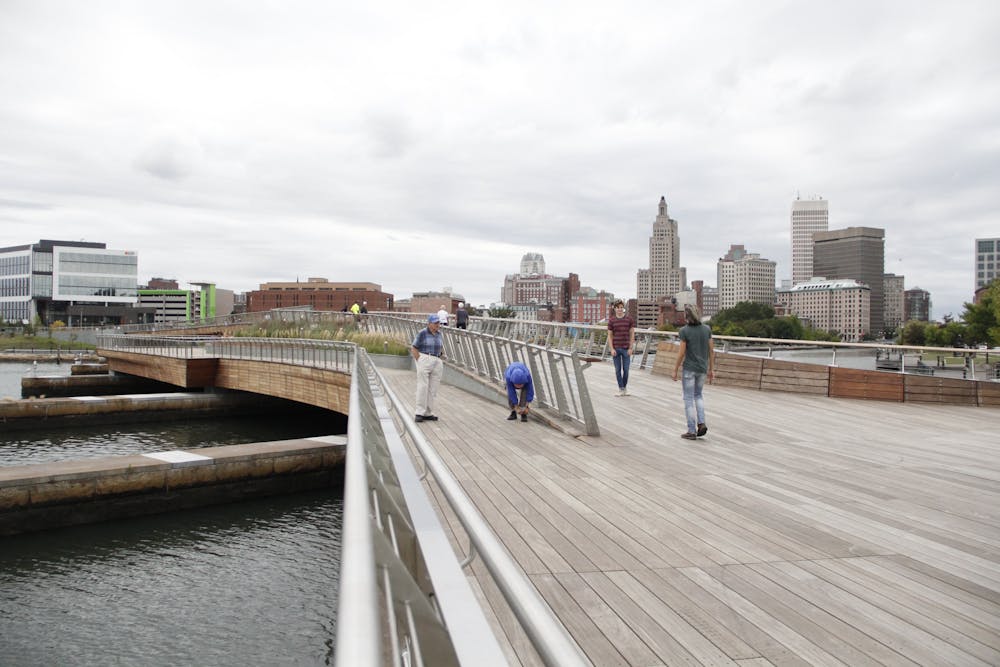On any given day, numerous students can be found cycling around Brown’s campus on their way to and from classes, clubs and other activities.
Several student groups support these riders — providing bikes and repairs and advocating for policy that creates a more bikeable campus.
Bikes at Brown, a student group that offers access to bikes on campus, provides several services to student cyclists, including open, free repair sessions, said Isaac Slevin ’25, a mechanic for the group.
As a Student Activities Office-recognized group, the club gets “a bit of money from Brown to be able to buy the parts that we use to fix bikes,” Slevin explained.
The group also offers a free bike rental program — 16 bikes available for a week at a time, Slevin explained. “(Students) just show up to the shop during shop hours, sign a release waiver, (and) get fitted (for) a bike and a helmet.”
“It’s exciting that we’re at capacity and so many kids are trying to rent bikes,” Slevin said.
Bikes at Brown is located in the Urban Environmental Lab’s garage, which physically restricts the size of its rental stock. “We would love to double the size of our rental fleet, but we just don’t have the space for it,” Slevin said.
The Brown Urban Mobility Project and the Brown Pedestrianization also have biking-related goals, said Noah Howard ’25, a senior organizer at BUMP.
Multiple students voiced concerns about actions that the University has taken regarding bike accessibility. In the recent memorandum of understanding between Providence’s private colleges and the city, Providence agreed to support colleges’ master planning efforts to “reduce bike parking requirements … in recognition of the increased availability/use of bike/scooter sharing services.”
Al Dahlberg, assistant vice president for government and community relations at Brown, said that private city data shows that student use of bike- and scooter-sharing services around campus has increased. “We think — and told the city — (that) it’s important that the city re-examine the requirements for bike parking, in light of the … proliferation of bike-share and scooters,” Dahlberg said.
“From a policy perspective, Brown is making it harder for students to bike,” Slevin said, adding that bike racks near popular spots on campus like the Sharpe Refectory are always full.
Dahlberg noted that “Brown has been committed to alternative transportation for a long time, and that’s reflected in each one of our institutional master plans.”
Still, if claims about full bike racks are true, “we need to do something about that,” Dahlberg said. “If there are needs that are not being met, we need to have that conversation.”
Slevin and Walker also pointed to the University’s 2021 efforts to fight the construction of a bike lane on South Water Street as planning harmful to bikeability.
“By fighting against that bike lane, the University is subscribing to a car-centric view of urban planning … that is not very forward-looking and is not very well considered,” Walker said.
The University “co-signed a letter to the city that expressed concerns about the way that bike lane is configured,” Dahlberg explained. “We said in the letter that we support a bike lane, but we wanted the city to consider alternative configurations that would resolve the safety concerns at that juncture.”
The University’s safety concern related to the building at 121 South Main Street, which houses the Brown University School of Public Health and other businesses. The building’s loading dock opens toward South Water Street and the bike lane. “For many deliveries, the trucks have to back in. The way that bike lane was designed … the big (trucks) block the only lane of traffic,” Dahlberg said.
Given this, the University “encouraged the city to think more deeply about how to configure (the bike lane) in a safe way,” Dahlberg said. “But we’ve always told the city prior to that — and after that — we do support a bike lane.”
Biking around campus has its challenges, like rough weather, hilly terrain and the fear of theft. Walker mentioned an additional concern: “Providence drivers do not respect bikes in the ways that they should, and there is not the proper infrastructure to protect bikers.”
Still, biking can offer a moment of contemplation, said Juliana Merullo ’24. “Some of the moments where I reflect on being happy at Brown are while I’m on my bike,” she said.
Biking also saves students time when commuting to classes. Biking “cuts my time to get to class down from ten minutes (of) walking to two minutes,” said Ian Stettner ’25.
Biking also enables students to explore the local area. Lay o’ the Land, a cycling map of the Providence area published by local bike shop Legend Bicycle, helps students traverse the city on two wheels.
“When we started Legend, the first thing we did was we published a map for people to orient themselves and to find routes … for bicycles,” Legend Bicycle owner Jack Madden said. The map has been republished three times, he added. That has “shown the progression … toward developing an on-road bicycle network” in the city.





